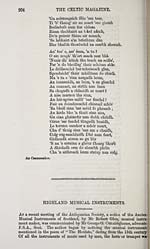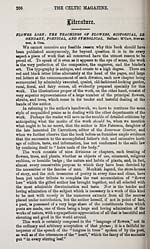Blair Collection > Celtic magazine > Volume 5
(215)
Download files
Complete book:
Individual page:
Thumbnail gallery: Grid view | List view

HIGHLAND MUSICAL INSTEUMENTS. 205
probably the most primitiTe. The discovery of a trumpet of bronze at
Caprington, in Ayrshire, showed that metallic inatraments of this kind
had been in use in Scotland before the dawn of history. He next noticed
the bagpipe, which had been styled the national instrument, but waa not
peculiar to Scotland, having been at one time popular in all parts of
Europe. There was no evidence to show when the instrument was intro-
duced into Scotland. The Exchequer Kolls record a payment to the
King's pipers in 13G2. Pipers formed part of the municipal institutions
of every large town, and in some burghs, as Jedburgh for instance, the
office was hereditary. But it was in the Highlands, among the Celtic
population, that the pipes were most popular. The author possessed a
set of Highland bagpipes (which were exhibited) bearing the exceedingly
early date of 1409. This instrument possessed only two small drones
and chanter, and previous to the beginning of last century bagpipes in
this country had no large or bass drone. But if the Gael could not claim
the merit of inventing the bagpipes, he could at least boast that he had
made the instrument his own by inventing a style of execution which had
turned its imperfections into beauties, and composed a rich and varied
stock of music so specially adapted for it that it could not be properly
rendered by any other instrument. The old name of the harp was the
clarsach, and it appears frequently in Scottish documents. The last
native harper in Scotland was Murdoch Macdonald, a retainer of Maclean
of CoU, who died about 1739. The lute is familiar to all readers of Scot-
tish poetry, from Davy Lindsay's mention of it, and other allusions of
constant occurrence. It appears in the accounts of the Lord High
Treasurer 1474. Originally it had eight thin catgut strings arranged in
four pairs, tuned in unison. In course of time more strings were added,
and during the seventeenth century it had twenty-four strings. In con-
clusion, the author remarked that there had been great improvements in
the construction of musical instruments in modern times, but it was ques-
tionable whether what had been gained in one respect had not been lost
in another by lessening the individuality of the separate instruments.
The paper was illustrated by a series of beautiful water-colour drawings
of nearly 100 musical instruments by Mr Glen.
In reference to the Highland bagpipes the following letter appeared
in a recent issue of the Scotsman : —
" Kinlochmoidart, Fort-William, February 13, 1880.
"Sir, — In your issue of the 10th inst., in reporting proceedings of
the Society of Antiquaries, mention is made of a bagpipe bearing the date
1409. I have the chanter and blow pipe of one which I believe to be
older. Its history is this : — It was given in the end of last century to
my maternal uncle, Donald Macdonald of Kinlochmoidart, Colonel of the
Royals (who I now represent), by the MTntyres, who were the hereditary
pipers to the Clanranald branch of the Macdonalds, as they were on the
point of emigrating to America. They told him the Macdonalds had
followed its inspiring strains into the battle of Bannockburn, and that it
had never been played at any lost battle ; that believing him to be the
chief of the Macdonalds, they left it with him as the proper person to
have it. The chanter is perfect, and the worn state of the holes shows it
to have been much used. — I am, &c.,
" WM. KOBEETSON MACDONALD."
probably the most primitiTe. The discovery of a trumpet of bronze at
Caprington, in Ayrshire, showed that metallic inatraments of this kind
had been in use in Scotland before the dawn of history. He next noticed
the bagpipe, which had been styled the national instrument, but waa not
peculiar to Scotland, having been at one time popular in all parts of
Europe. There was no evidence to show when the instrument was intro-
duced into Scotland. The Exchequer Kolls record a payment to the
King's pipers in 13G2. Pipers formed part of the municipal institutions
of every large town, and in some burghs, as Jedburgh for instance, the
office was hereditary. But it was in the Highlands, among the Celtic
population, that the pipes were most popular. The author possessed a
set of Highland bagpipes (which were exhibited) bearing the exceedingly
early date of 1409. This instrument possessed only two small drones
and chanter, and previous to the beginning of last century bagpipes in
this country had no large or bass drone. But if the Gael could not claim
the merit of inventing the bagpipes, he could at least boast that he had
made the instrument his own by inventing a style of execution which had
turned its imperfections into beauties, and composed a rich and varied
stock of music so specially adapted for it that it could not be properly
rendered by any other instrument. The old name of the harp was the
clarsach, and it appears frequently in Scottish documents. The last
native harper in Scotland was Murdoch Macdonald, a retainer of Maclean
of CoU, who died about 1739. The lute is familiar to all readers of Scot-
tish poetry, from Davy Lindsay's mention of it, and other allusions of
constant occurrence. It appears in the accounts of the Lord High
Treasurer 1474. Originally it had eight thin catgut strings arranged in
four pairs, tuned in unison. In course of time more strings were added,
and during the seventeenth century it had twenty-four strings. In con-
clusion, the author remarked that there had been great improvements in
the construction of musical instruments in modern times, but it was ques-
tionable whether what had been gained in one respect had not been lost
in another by lessening the individuality of the separate instruments.
The paper was illustrated by a series of beautiful water-colour drawings
of nearly 100 musical instruments by Mr Glen.
In reference to the Highland bagpipes the following letter appeared
in a recent issue of the Scotsman : —
" Kinlochmoidart, Fort-William, February 13, 1880.
"Sir, — In your issue of the 10th inst., in reporting proceedings of
the Society of Antiquaries, mention is made of a bagpipe bearing the date
1409. I have the chanter and blow pipe of one which I believe to be
older. Its history is this : — It was given in the end of last century to
my maternal uncle, Donald Macdonald of Kinlochmoidart, Colonel of the
Royals (who I now represent), by the MTntyres, who were the hereditary
pipers to the Clanranald branch of the Macdonalds, as they were on the
point of emigrating to America. They told him the Macdonalds had
followed its inspiring strains into the battle of Bannockburn, and that it
had never been played at any lost battle ; that believing him to be the
chief of the Macdonalds, they left it with him as the proper person to
have it. The chanter is perfect, and the worn state of the holes shows it
to have been much used. — I am, &c.,
" WM. KOBEETSON MACDONALD."
Set display mode to: Large image | Transcription
Images and transcriptions on this page, including medium image downloads, may be used under the Creative Commons Attribution 4.0 International Licence unless otherwise stated. ![]()
| Early Gaelic Book Collections > Blair Collection > Celtic magazine > Volume 5 > (215) |
|---|
| Permanent URL | https://digital.nls.uk/76451417 |
|---|
| Description | Volume V, 1880. |
|---|---|
| Shelfmark | Blair.6 |
| Attribution and copyright: |
|
| Description | A selection of books from a collection of more than 500 titles, mostly on religious and literary topics. Also includes some material dealing with other Celtic languages and societies. Collection created towards the end of the 19th century by Lady Evelyn Stewart Murray. |
|---|
| Description | Selected items from five 'Special and Named Printed Collections'. Includes books in Gaelic and other Celtic languages, works about the Gaels, their languages, literature, culture and history. |
|---|

